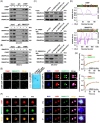Therapeutic targeting of CNBP phase separation inhibits ribosome biogenesis and neuroblastoma progression via modulating SWI/SNF complex activity
- PMID: 37186134
- PMCID: PMC10131295
- DOI: 10.1002/ctm2.1235
Therapeutic targeting of CNBP phase separation inhibits ribosome biogenesis and neuroblastoma progression via modulating SWI/SNF complex activity
Abstract
Background: Neuroblastoma (NB) is the most common extracranial malignancy in childhood; however, the mechanisms underlying its aggressive characteristics still remain elusive.
Methods: Integrative data analysis was performed to reveal tumour-driving transcriptional regulators. Co-immunoprecipitation and mass spectrometry assays were applied for protein interaction studies. Real-time reverse transcription-polymerase chain reaction, western blotting, sequential chromatin immunoprecipitation and dual-luciferase reporter assays were carried out to explore gene expression regulation. The biological characteristics of NB cell lines were examined via gain- and loss-of-function assays. For survival analysis, the Cox regression model and log-rank tests were used.
Results: Cellular nucleic acid-binding protein (CNBP) was found to be an independent factor affecting NB outcome, which exerted oncogenic roles in ribosome biogenesis, tumourigenesis and aggressiveness. Mechanistically, karyopherin subunit beta 1 (KPNB1) was responsible for nuclear transport of CNBP, whereas liquid condensates of CNBP repressed the activity of switch/sucrose-nonfermentable (SWI/SNF) core subunits (SMARCC2/SMARCC1/SMARCA4) via interaction with SMARCC2, leading to alternatively increased activity of SMARCC1/SMARCA4 binary complex in facilitating gene expression essential for 18S ribosomal RNA (rRNA) processing in tumour cells, extracellular vesicle-mediated delivery of 18S rRNA and subsequent M2 macrophage polarisation. A cell-penetrating peptide blocking phase separation and interaction of CNBP with SMARCC2 inhibited ribosome biogenesis and NB progression. High KPNB1, CNBP, SMARCC1 or SMARCA4 expression or low SMARCC2 levels were associated with poor survival of NB patients.
Conclusions: These findings suggest that CNBP phase separation is a target for inhibiting ribosome biogenesis and tumour progression in NB via modulating SWI/SNF complex activity.
Keywords: SWI/SNF complex; cellular nucleic acid-binding protein; karyopherin subunit beta 1; phase separation; ribosome biogenesis; tumour progression.
© 2023 The Authors. Clinical and Translational Medicine published by John Wiley & Sons Australia, Ltd on behalf of Shanghai Institute of Clinical Bioinformatics.
Conflict of interest statement
The authors declare that they have no competing interests.
Figures








References
-
- Armas P, Coux G, Weiner AMJ, et al. What's new about CNBP? Divergent functions and activities for a conserved nucleic acid binding protein. Biochim Biophys Acta Gen Subj. 2021;1865:129996. - PubMed
-
- Margarit E, Armas P, García Siburu N, et al. CNBP modulates the transcription of Wnt signaling pathway components. Biochim Biophys Acta. 2014;1839:1151‐1160. - PubMed
Publication types
MeSH terms
Substances
LinkOut - more resources
Full Text Sources
Medical
Molecular Biology Databases
Miscellaneous
